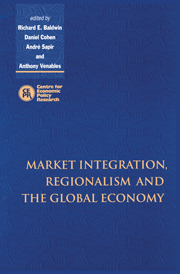Book contents
- Frontmatter
- Contents
- List of figures
- List of tables
- Preface
- Acknowledgements
- List of conference participants
- 1 Introduction
- PART ONE REGIONALISM AND THE GLOBAL ECONOMY
- PART TWO MARKET INTEGRATION AND REGIONALISM
- 7 Operationalising the theory of optimum currency areas
- Discussion
- 8 European migrants: an endangered species?
- Discussion
- 9 Geography and specialisation: industrial belts on a circular plain
- Discussion
- 10 Convergence … an overview
- Discussion
- 11 Convergence as distribution dynamics (with or without growth)
- Discussion
- Index
8 - European migrants: an endangered species?
Published online by Cambridge University Press: 24 February 2010
- Frontmatter
- Contents
- List of figures
- List of tables
- Preface
- Acknowledgements
- List of conference participants
- 1 Introduction
- PART ONE REGIONALISM AND THE GLOBAL ECONOMY
- PART TWO MARKET INTEGRATION AND REGIONALISM
- 7 Operationalising the theory of optimum currency areas
- Discussion
- 8 European migrants: an endangered species?
- Discussion
- 9 Geography and specialisation: industrial belts on a circular plain
- Discussion
- 10 Convergence … an overview
- Discussion
- 11 Convergence as distribution dynamics (with or without growth)
- Discussion
- Index
Summary
Introduction
Economists and policy-makers alike typically complain about insufficient labour mobility within Europe. Yet, large internal migrations have been an enduring phenomenon in European economic history. Even in the nineteenth century, when Europeans went in great numbers to overseas destinations in an attempt to escape from deprivation and persecutions at home, intra-European migrations were quite large. During the 1890–1913 period, 6.596 million Italians migrated to the United States or to Latin America and 4.874 million went to European destinations (Ferenczi and Willcox, 1934). Similarly, a substantial share of Spanish migrants chose to migrate toward Europe, despite their cultural and political links with Latin America (Hatton and Williamson, 1994). The peak of intra-European migration came somewhat later, during the 1950s and 1960s, when overseas emigration fell abruptly and approximately 10.5 million migrants crossed European borders, mainly from Southern to Northern Europe (Razin and Sadka, 1995).
From an historical point of view, therefore, the lack of labour mobility within Europe is somewhat surprising. The evidence is however undisputed: intra-European labour mobility has indeed reached an historical low and compares quite unfavourably with similar findings for the United States. In turn, low labour mobility is a matter of great concern for European policy-makers. The reasons for this concern are well known. In the face of an idiosyncratic shock, regions can adjust by letting their exchange rate depreciate, by a drop in the real wage or by migration. The first option is unpalatable, as it may clash with the commitments of the European exchange rate system and the desire to fight off inflation.
- Type
- Chapter
- Information
- Market Integration, Regionalism and the Global Economy , pp. 228 - 251Publisher: Cambridge University PressPrint publication year: 1999
- 10
- Cited by



